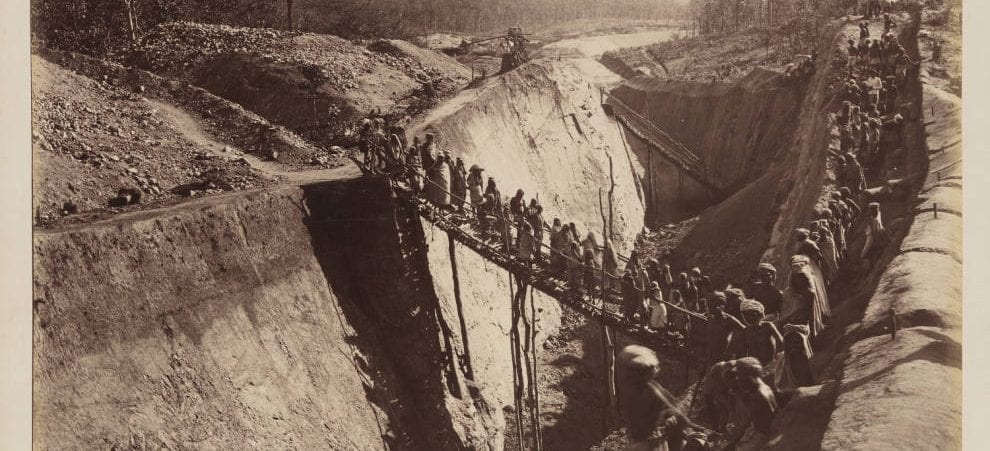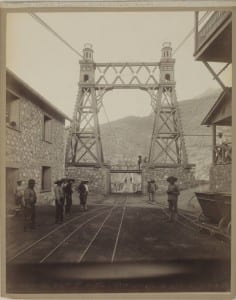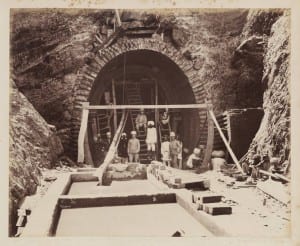http://digitalcollections.smu.edu/cdm/ref/collection/mex/id/1823
This picture is titled “North Tower Suspension Bridge” and was created by Baldwin Locomotive Works. It is part of a series of photos focused on the Mapimi Railroad in Durango, Mexico, all of which were taken within a period of about 20 years from 1890-1909.
The photograph itself is quite striking, as the wild mountains in the distance are contrasted with the sedentary life depicted by the village. Connecting the mountains and the village is a suspension bridge, which appears to be extremely sturdy presumably due to the fact that the bridge would need to be able to hold the weight of whatever crossed the tracks. From looking at the village in the foreground of the picture, it appears to be very rural due to the simple stone and wood buildings. The railroad tracks run through the village, over the bridge, and into the mountains. However, due to the low hanging arch, the small width of the tracks, and the cart on the tracks in the bottom right corner of the photograph, I doubt this bridge was used for any large locomotives during this time period.
There are 16 men standing around throughout the photograph, all of whom appear to be Mexicans based on how they are dressed. The men are posted far away on the bridge, overlooking from windows or patios, or standing near the tracks on the village, which provides a great perspective on how far the bridge stretches into the distance. In addition to the seemingly perfect spacing in the photo, all of the men except for one are making eye contact with the camera. This makes me wonder if this photograph was posed. If indeed the photograph was posed, it also raises the question of the intended purpose of the photographer.
http://digitalcollections.smu.edu/cdm/ref/collection/eaa/id/1473
This photograph is titled “Photograph No. 9”, and belongs to the first album in a two album series centered on the construction of the Bengal-Nagpur Railway in India. The album consists of photographs from the years 1890 – 1899, but our focus will be on Photograph No. 9, which was taken in the year 1890. Like many pictures early in the history of photography, the original Photograph No. 9 was an albumen print, which was a process where protein found in egg whites was used to bind other chemicals to paper, creating the photograph.
Photograph No. 9 shows the process of building the Bengal-Nagpur Railway, which is quite evident from all of the tools and supplies around the entrance of the tunnel. In the tunnel, there are ladders and supports that would have been used to keep the tunnel from collapsing during construction, as well as providing the workers with a more advantageous position to continue building. Built right into the side of a mountain face, constructing this tunnel would have been especially dangerous due to the large amounts of TNT needed to blast through the rock.
There are several people pictured throughout the photograph, both Indian and British. Although it is not explicitly stated, one can infer the nationality of every man based on their dress and skin color. The Indian men have much darker skin and are dressed in more traditional Indian garb, accentuated by their large headwear. The British men have much lighter skin tones and are also dressed in a more typically European style, with two of the men dressed as if they are on a safari. Presumably, due to societal roles, the British males would have been in charge in the situation, possibly as managers or engineers. One of the more intriguing aspects of this photograph is the sharp contrast between the people who are blurred due to their movement against those in the center of the picture, who are entirely still. Yet again, I cannot help but wonder if perhaps this photograph’s truthfulness has been altered due to this irregularity.



